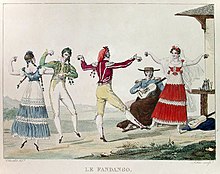And, really, why not?
The original fandango looked like this:

A fandango from the 1700s, by Pierre Chasselat
But if that looks a little worrying - not to say camp - then do not fear. There are many sorts of fandangos for all shapes, sizes and conditions of men.
Fandangos grandes (big fandangos) are normally danced by couples, start out slowly and gradually get faster.
Fandanguillos (little fandangos) are lively dances for festivals.
In the Philippines, the fandango has developed into the Pandanggo sa Ilaw (Fandango of Lights). If you are a woman you have to dance this fandango balancing a small lantern on your head.
Hm. Perhaps you'd better not attempt that one. Not indoors, anyway.
In Portugal the fandango is basically a contest between (usually) two men to show off their best moves.
If you're not sure how to fandango then this should give you the idea:
So, really, anyone can do it. The story goes that when the dance was about to be banned by the Roman Catholic Church the judge-priests got so excited by the demonstration they were given that they jumped up, joined in...and the fandango was never banned after all.
You really can't dance?
Really?
Well, in that case then I suppose you'll have to go for the figurative sort of fandango, and just make a great big enormous fuss.
Word To Use Today: fandango. This word comes from Spanish, but no one's sure where it came from before that.
No comments:
Post a Comment
All comments are very welcome, but please make them suitable for The Word Den's family audience.